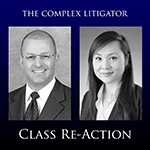I’m testing out opening sentences. The first candidate is: “The objective import of Noel v. Thrifty Payless, Inc. (July 29, 2019) is easy to ascertain.” You can see how that’s an option. It includes “objective,” as in the class definition must state the class with objective characteristics. And it drops in “ascertain,” as in this is a decision about the ascertainability requisite for certification. I like it. No second option for you.
Noel is a putative class action brought on behalf of retail purchasers of an inflatable outdoor pool sold in packaging that was allegedly misleading about the pool’s characteristics. The trial court denied the representative plaintiff’s motion for class certification on the basis that the plaintiff did not supply evidence showing how class members might be individually identified when the time came to do so. The Court of Appeal upheld the trial court, reasoning that such evidence was necessary to ensure that proper notice would be given to the class. The Supreme Court said, “Nah, brah.”
The Supreme Court reviewed the history of the “ascertainability” requisite. The first view of the requisite focuses on the nature of the definition of the class:
One view of ascertainability concentrates on the proposed class definition itself. This viewwas applied in Bartold v. Glendale Federal Bank (2000) 81Cal.App.4th 816 (Bartold), superseded by statute on another point as stated in Markowitz v. Fidelity Nat. Title Co. (2006) 142Cal.App.4th 508, 524. The Bartold court explained that “[a] class is ascertainable if it identifies a group of unnamed plaintiffs by describing a set of common characteristics sufficient to allow a member of that group to identify himself or herself as having a right to recover based on the description.” (81 Cal.App.4th at p.828.) This basic view of ascertainability has been reiterated by numerous other Courts of Appeal, including the courts in Estrada, supra, 154 Cal.App.4th at page 14 and Aguirre, supra, 234 Cal.App.4th at pages 1299 to 1300. (See also Aguirre, at p. 1300 [listing cases].) A similar formulation regards a class as ascertainable when it is defined “in terms of objective characteristics and common transactional facts” that make “the ultimate identification of class members possible when that identification becomes necessary.” (Hicks, supra, 89Cal.App.4that p.915.)
Slip op., at 21. The second formulation of the requisite was summarized as follows:
The second basic view of ascertainability entails a more exacting inquiry. One such articulationregards the ascertainabilityrequirementas calling for an examination into“(1) the class definition, (2) the size of the class and (3) the means of identifying class members.” (Miller v. Woods (1983) 148 Cal.App.3d 862, 873 (Miller); see also Noel, supra, 17 Cal.App.5th at p. 1324, Sotelo, supra, 207 Cal.App.4th at p. 648; Reyes v. Board of Supervisors (1987) 196 Cal.App.3d 1263, 1274.) Consistent with this view, it has been said that “[c]lass members are ‘ascertainable’ where they may be readily identified without unreasonable expense or time by reference to official records.” (Rose v. City of Hayward (1981) 126 Cal.App.3d 926, 932 (Rose).) On its face, the quoted language from Rose could be understood as specifying a sufficient, as opposed to a necessary, basis for finding an ascertainable class within the Miller framework. But some courts, drawing from Rose’s focus on the mechanics of identifying class members, have gone further and required a class plaintiff to make a specific factual or evidentiary showing in order to show an ascertainable class.
Slip op., at 21-22. The Court then looked at the similar divide in the federal system, focusing extensively on the Seventh Circuit’s analysis of the requisite in Mullins v. Direct Digital, LLC, 795 F.3d 654 (7th Cir. 2015). After that extensive review of competing approaches, the Supreme Court concluded that the process protection provided by an objective and clear class definition was more significant to the ascertainability requirement than the goal of notice to each class member. From that conclusion a clear rule followed:
As a rule, a representative plaintiff in a class action need not introduce evidence establishing how notice of the action will be communicated to individual class members in order to show an ascertainable class.
Slip op., at 38. The Court expressly disapproved of strict reliance upon Rose as stating the requirement for an ascertainability showing. Slip op., at 41, n. 15.
The Court observed that a trial court could consider how notice will be provided to a class as a separate inquiry into, e.g., manageability. Slip op., at 42. It emphasized, however, that notice was not an aspect of the ascertainability showing. The decision of the Court was unanimous.
Christopher Wimmer and Peter Roldan of Emergent Legal and Leslie Brueckner and Karla Gilbride of Public Justice represented the successful Plaintiff and Appellant.











